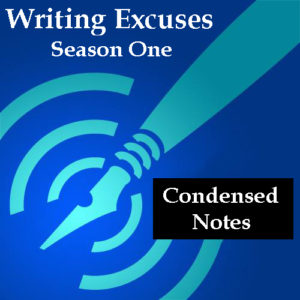Posted on May 9, 2020
Writing Excuses Notes: Pacing
Here are some notes I took after listening to Writing Excuses.
It is an educational podcast that helps novelists/writers.
The topic is about pacing.
It comes from Season 1, Episode 10.
Pacing
How do you keep the tension up/make it “snappy”?
“In late, out early”.
- Jump straight to the conflict and remove filler.
Cram in as much conflict as possible. When building characters, give them multiple scenes.
Figure out what each scene’s job is. Only write what needs to happen, then move on.
Jump to the next conflict or important bit. Don’t “keep going until the next day”.
Prewrite! Treat each scene like a story in it of itself. Take the time to plan.
Make sure you know the purpose, the point and the main conflict of the scene.
KEY: Don’t just stick it in because its cool.
Keep a point. Foreshadowing is needed.
- Not all scenes need to be intense/exciting. Some simply explain a character or setting.
Even then, you need tension.
- Let some of the air out without deflating tension. Even thrillers need breathing room.
Don’t drag your characters over nails and broken glass for the entire story.
Some Plot Frameworks/Tools:
- Time-bombs: Establish a time limit. Provide urgency.
- Readers want to see progress. Have the characters make headway/grow stronger.
- Travelogue: A series of places – Know where your characters are going (Follow the map).
- Countdown: A series of tasks to accomplish. A checklist, Add new, original tasks.
How do you keep the small issues from overwhelming your larger plot? How do you stay on task?
- Prewrite. Know where you’re going.
- Cram in as much as possible. When you plan, focus on main and small objectives.
- Connect everything together. Pacing is all about preparation.





